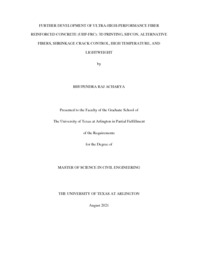
ATTENTION: The works hosted here are being migrated to a new repository that will consolidate resources, improve discoverability, and better show UTA's research impact on the global community. We will update authors as the migration progresses. Please see MavMatrix for more information.
Show simple item record
| dc.contributor.advisor | Chao, Shih-Ho | |
| dc.creator | Acharya, Bhupendra Raj | |
| dc.date.accessioned | 2023-06-27T23:49:30Z | |
| dc.date.available | 2023-06-27T23:49:30Z | |
| dc.date.created | 2021-08 | |
| dc.date.issued | 2021-08-10 | |
| dc.date.submitted | August 2021 | |
| dc.identifier.uri | http://hdl.handle.net/10106/31347 | |
| dc.description.abstract | Introduction of artificial intelligence (AI) and machine learning in manufacturing industry also in every service industry, decreasing conventional skilled workforce and stagnated construction industry, probability and past statistics of the accident at the construction sites and difficulty in quality control has led the researchers to think of the solution and alternatives of the conventional construction. A new construction paradigm, known as 3-D concrete printing or additive manufacturing of concrete (AMC) provides such a solution. This research focuses on a preliminary study in 3d printed ultra-high-performance fiber-reinforced concrete (UHP-FRC) and, has developed a novel mix that has balanced extrude-ability and buildability. In addition to this, to get an idea of highest possible mechanical properties of fiber reinforced concrete, ultra-high-performance slurry infiltrated fiber-reinforced concrete (UHP-SIFCON) has developed. The developed UHP-SIFCON can exhibit very high compressive strength more than 33 ksi for an equivalent compressive strain of 8% and high tensile strength of 2.34 ksi for an equivalent tensile strain of 1.07 %. The study further investigates the performance of UHP-FRC with different types of fiber for direct tensile loading. Furthermore, the study examines early age shrinkage cracking and its mitigation measures. The use of UHF-FRC has been observed more severe failure in elevated temperature. So this study examines the performance of UHP-FRC at high temperatures and investigates the mitigation measures. At last, the study investigates reducing the unit weight of existing UHP-FRC and develops Lightweight high strength concrete with weight 60-70% of the weight of conventional UHP-FRC having 28 days compressive strength comparable to normal weight concrete. Any reduced weight can significantly reduce the design and construction work in other structural members such as columns, beams, and foundations. For buildings in high seismic areas, the reduced self-weight can lead to much smaller inertial forces thereby potentially reducing the damage induced by earthquakes. | |
| dc.format.mimetype | application/pdf | |
| dc.language.iso | en_US | |
| dc.subject | Ultra-high-performance fiber reinforced concrete (uhp-frc) | |
| dc.subject | 3d printing | |
| dc.subject | Sifcon | |
| dc.subject | Alternative fibers | |
| dc.subject | Shrinkage crack control | |
| dc.subject | High temperature | |
| dc.subject | Lightweight concrete | |
| dc.title | FURTHER DEVELOPMENT OF ULTRA-HIGH-PERFORMANCE FIBER REINFORCED CONCRETE (UHP-FRC): 3D PRINTING, SIFCON, ALTERNATIVE FIBERS, SHRINKAGE CRACK CONTROL, HIGH TEMPERATURE, AND LIGHTWEIGHT | |
| dc.type | Thesis | |
| dc.date.updated | 2023-06-27T23:49:30Z | |
| thesis.degree.department | Civil Engineering | |
| thesis.degree.grantor | The University of Texas at Arlington | |
| thesis.degree.level | Masters | |
| thesis.degree.name | Master of Science in Civil Engineering | |
| dc.type.material | text | |
Files in this item
- Name:
- ACHARYA-THESIS-2021.pdf
- Size:
- 11.06Mb
- Format:
- PDF
This item appears in the following Collection(s)
Show simple item record


